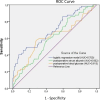Perioperative risk factors for postoperative delirium after hemiarthroplasty in geriatric hip fractures: A prospective observational study
- PMID: 40419921
- PMCID: PMC12113965
- DOI: 10.1097/MD.0000000000042025
Perioperative risk factors for postoperative delirium after hemiarthroplasty in geriatric hip fractures: A prospective observational study
Abstract
The aim of the study was to investigate the predictors of postoperative delirium (POD) in elderly hip fracture patients, as well as the effects of POD on in-hospital results, including complications, duration of hospital stay, and mortality. In this prospective cohort study, 225 consecutive hip hemiarthroplasty patients over the age of 65 who underwent surgery at a high-volume training and research hospital between June 2021 and June 2023 were investigated. Pathological fracture, death within the postoperative first 5 days, and missing data were exclusion criteria. The collected data included demographics, laboratory examination results, and comorbidities. The main outcome measure was POD, and the assessment tool for delirium was the Confusion Assessment Method. All patients were assessed daily in terms of POD for at least 5 postoperative days. To determine independent predictors of POD, univariate and multivariate logistic regression analyses were carried out. The receiver operating characteristic (ROC) curve was used to investigate the predictive performance of the logistic regression model and determine optimal cutoff points. Fifty-seven (25.3%) patients were diagnosed with delirium. Multivariate analysis showed that lower postoperative albumin (OR: 0.43, P = .012), higher postoperative blood glucose (OR: 1.01, P < .001), and the presence of preoperative delirium (OR: 8.44, P = .003) were independent predictive factors for POD. According to the ROC curves, the area under curve value of the predictive model was 0.700 (95% CI: 0.619-0.781, P < .001), indicating good discriminative ability. The optimal cutoff values of the postoperative blood glucose and postoperative albumin levels for delirium prediction were calculated at 141.5 mg/dL and 3.11 g/dL. The POD group experienced a significantly greater rate of in-hospital mortality as well as longer hospital stays (P = .004 and.012, respectively). Our data suggest that preoperative delirium, higher postoperative blood glucose, and lower postoperative serum albumin levels can be used as perioperative predictors of POD in patients undergoing hemiarthroplasty for hip fracture. Closely monitoring patients with postoperative blood glucose ≥ 141.5 mg/dL and postoperative serum albumin ≤ 3.11 g/dL and implementing preventative strategies may be beneficial to improve patient outcomes.
Keywords: albumin; delirium; glucose; hip hemiarthroplasty; risk factor.
Copyright © 2025 the Author(s). Published by Wolters Kluwer Health, Inc.
Conflict of interest statement
The authors have no funding and conflicts of interest to disclose.
Figures

Similar articles
-
Preoperative Prognostic Nutritional Index Is a Predictive Factor for Postoperative Delirium in Elderly Patients with Femoral Neck Fracture.Clin Interv Aging. 2025 Jul 2;20:941-950. doi: 10.2147/CIA.S518366. eCollection 2025. Clin Interv Aging. 2025. PMID: 40621090 Free PMC article.
-
Cephalomedullary nails versus extramedullary implants for extracapsular hip fractures in older adults.Cochrane Database Syst Rev. 2022 Jan 26;1(1):CD000093. doi: 10.1002/14651858.CD000093.pub6. Cochrane Database Syst Rev. 2022. PMID: 35080771 Free PMC article.
-
Arthroplasties for hip fracture in adults.Cochrane Database Syst Rev. 2022 Feb 14;2(2):CD013410. doi: 10.1002/14651858.CD013410.pub2. Cochrane Database Syst Rev. 2022. PMID: 35156194 Free PMC article.
-
Preoperative low-dose dexmedetomidine reduces postoperative delirium in elderly patients with hip fracture under spinal anesthesia: A randomized, double blind, controlled clinical study.J Clin Anesth. 2025 Jul;105:111897. doi: 10.1016/j.jclinane.2025.111897. Epub 2025 Jun 12. J Clin Anesth. 2025. PMID: 40513143 Clinical Trial.
-
Intravenous versus inhalational maintenance of anaesthesia for postoperative cognitive outcomes in elderly people undergoing non-cardiac surgery.Cochrane Database Syst Rev. 2018 Aug 21;8(8):CD012317. doi: 10.1002/14651858.CD012317.pub2. Cochrane Database Syst Rev. 2018. PMID: 30129968 Free PMC article.
Cited by
-
The incidence and risk factors of perioperative delirium in elderly patients with hip fracture under the Unaccompanied- Care model.J Orthop Surg Res. 2025 Jul 21;20(1):693. doi: 10.1186/s13018-025-06114-2. J Orthop Surg Res. 2025. PMID: 40691853 Free PMC article.
-
Development and validation of a nomogram for predicting in-hospital mortality in older adult hip fracture patients with atrial fibrillation: a retrospective study.Front Med (Lausanne). 2025 Jul 23;12:1605437. doi: 10.3389/fmed.2025.1605437. eCollection 2025. Front Med (Lausanne). 2025. PMID: 40771462 Free PMC article.
References
-
- Hshieh TT, Inouye SK, Oh ES. Delirium in the elderly. Clin Geriatr Med. 2020;36:183–99. - PubMed
-
- Scholz AF, Oldroyd C, McCarthy K, Quinn TJ, Hewitt J. Systematic review and meta-analysis of risk factors for postoperative delirium among older patients undergoing gastrointestinal surgery. Br J Surg. 2016;103:e21–28. - PubMed
-
- Ten Broeke M, Koster S, Konings T, Hensens AG, van der Palen J. Can we predict a delirium after cardiac surgery? A validation study of a delirium risk checklist. Eur J Cardiovasc Nurs. 2018;17:255–61. - PubMed
Publication types
MeSH terms
Substances
LinkOut - more resources
Full Text Sources
Medical

